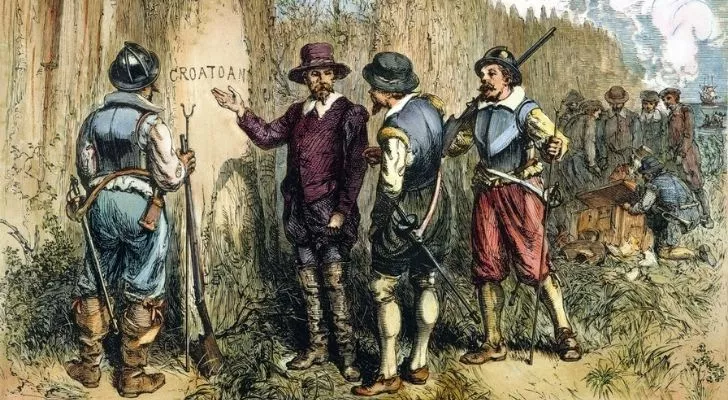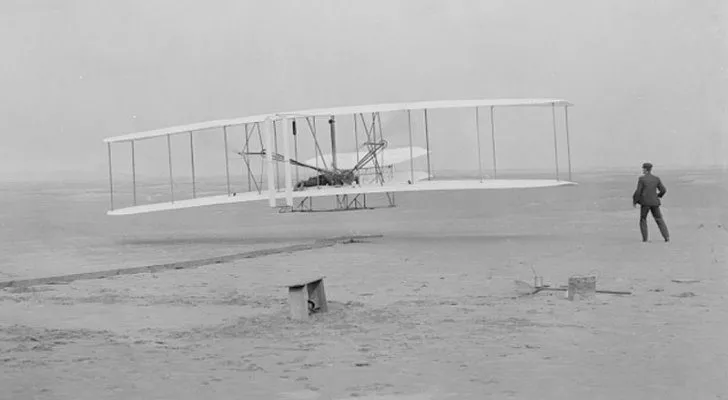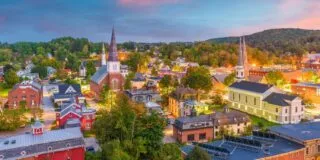Most commonly known as the Tar Heel State but also known as the Old North State and the Turpentine State, North Carolina was the 12th state to join the United States of America on November 21, 1789.
It has a population of 10,488,0841 people (as of 2019), making it the 9th most populous state. North Carolina is bordered by the states of South Carolina, Virginia, Tennessee, and Georgia.
With a total of 53,819 square miles (139,390 square kilometers) of land and water, it is the 28th largest state.
The capital of North Carolina is Raleigh, which is situated in the center of the state.
That’s enough fast facts about the Tar Heel State for now; we’re here to learn the more interesting facts!
North Carolina has been inhabited for at least 10,000 years!

The first people to inhabit North Carolina would have been the direct descendants of the Paleo-Indians who settled in the Americas.
These early nomads came into North America from the far east of modern-day Russia into what we now call Alaska via the Bering Strait sometime between 13-11,000 BC.
Over the next few thousand years, they slowly spread across North America and settled the land.
The earliest evidence we have of people living in the region we now call North Carolina comes from the Hardaway Site near the center of the state.
This archaeological site contains evidence of human existence, which dates back as far as 8,000 BC.
For the next seven or so thousand years, the people of this region lived a predominantly hunter-gatherer life.
Many different Native American Tribes were living in North Carolina when Europeans first arrived.

It wasn’t until around 1000 BC that the people living in modern-day North Carolina started settling in villages and living sedentary lives around agriculture.
By the time the first European explorers came upon the region, the people already living there had complex societies and often lived in large, developed towns.
At the point of contact, there were many tribes in the region, with some of the major tribes including but not limited to the Algonquian-speaking Croatan, Chowanoke, and Roanoke; the Iroquoian-speaking Cherokee, Tuscarora, and Meherrin; and the Siouan-speaking Catawba, Cheraw, Waccamaw, and Saponi.
The first European to set foot in North Carolina was Italian.

It was the Italian explorer Giovanni da Verrazzano who first encountered modern-day North Carolina as early as 1524.
He had set out in the service of King Francis I of France in the hopes of finding a route through to the Pacific Ocean.
He first made landfall at Cape Fear, just near the border between what is now North and South Carolina.
From there, he traveled north, making various brief expeditions inland on the way.
When Verrazzano came upon Pamlico Sound, the expansive lagoon at the mouth of the Pamlico river, he actually believed it to be the way through to the Pacific Ocean and sent his findings back to France.
The first Europeans to try to colonize North Carolina were the Spanish.

By the 1560s, Spain had already laid claims to parts of what we now call South Carolina.
In 1567 the Spanish explorer Captain Juan Pardo was sent north into the interior of North Carolina to claim the region for Spain and prepare it for a future colony.
He was tasked with making peace with the local tribes and initiating their conversion to Christianity.
Pardo’s route took him quite inland to Joara, a Native American settlement close to the present-day town of Morganton.
The settlement was promptly renamed Cuenca, and a garrison of 30 men was stationed there while Pardo continued his journey.
Pardo established six forts in total, all of which were completely destroyed by the displeased locals in 1568.
This was Spain’s one and only attempt to colonize the interior of North Carolina.
England’s first attempt to Colonize North Carolina was a complete failure.

This ill-fated attempt became one of the most mysterious tales to come from this early era of colonization.
We are, of course, talking about the Roanoke Colony. In 1585 the first attempt to establish the Roanoke Colony began when a group of 100 or so settlers landed on the shores of Roanoke Island, North Carolina.
The first wave of colonists was to establish a fort on the island and wait for a ship to return with further supplies, which ended up being greatly delayed.
Due to the delays, the colonists gave up on the colony and returned to England when a British ship just happened to pass by.
When the supply ship returned just a few days later, they found the island empty of colonists.
So, a small group of men was left behind to guard the fort and the new supplies while the ship returned to fetch a new group of settlers to populate the colony.
England’s second attempt to colonize North Carolina was even more disastrous than the first!

In 1857 the second wave of 136 colonists arrived at a once again empty fort.
This time, they found the bodies of the men who had been left behind, men who the local people seemingly slaughtered.
Relatively undeterred, they set their minds on establishing their new lives on Roanoke Island while the ship returned to England, once again to pick up supplies.
Yet again, the ship was delayed, this time by the outbreak of war between Spain and England.
It wasn’t until 1890 that a ship finally made it back to the colony, only to find the place completely abandoned.
Although defensive walls had been constructed, all other useful buildings and structures had been removed completely.
Carved into the walls of the colony were the words “CROATOAN.”
To this day, we still don’t know what happened to the colonists, but there are thousands of theories!
Some believe that angry locals slaughtered all the colonists, some think they grew ill and perished, and some are convinced they vanished into thin air and continue to haunt the site!
The first English child born in America was born in the infamous Roanoke colony.

The man responsible for the second attempt to settle the Roanoke Colony was the English aristocrat John White, who came to the island in 1587 along with his pregnant daughter.
On August 15, 1587, John’s daughter gave birth to Virginia Dare, making her the first child of English descent to be born in modern-day America.
Virginia disappeared along with the other colonists, but she didn’t disappear from history altogether.
Instead, she became a symbol for many in the thirteen colonies and eventually the US, with an endless number of places being named after her.
North Carolina was actually named after a king.

Believe it or not, North Carolina wasn’t named after someone called Carolina.
King James II instead named the colony after his father.
This gets a little confusing because his father was King Charles I, which at first appears to have no connection at all with the name Carolina.
However, the explanation is relatively simple in the end – the Latin word for Charles is Carolus; thus, the colony was named North Carolina.
North Carolina was a slave state.

While it could be said that North Carolina relied a little less on slavery than the other southern states, the truth is that slaves in the state were fewer in number simply because the state itself was much less populated.
The reality is that by 1860 there were at least 330,000 African American slaves, some 33% of the population, a number that was increasing year by year until the American Civil War began.
North Carolina was the last state to join the Confederacy.

North Carolina tried to avoid any participation in the American Civil War, most likely because they saw how potentially disastrous it could be.
As such, North Carolina was hesitant when the other southern states began to secede from the Union to form the Confederate States of America.
The act which eventually forced North Carolina’s hand was Abraham Lincoln demanding that they invade their sister state, newly Confederate South Carolina.
So it was that on May 20, 1860, North Carolina officially joined the Confederate States of America.
The world’s first successful powered aircraft flight happened in North Carolina.

While Orville and Wilbur Wright, later known simply as the Wright Brothers, grew up in Ohio, one of their greatest accomplishments took place near the town of Kitty Hawk, North Carolina.
The mechanically minded brothers never actually went to college; instead, they learned their craft by reading books and tinkering in their workshop.
Their first attempts to create a heavier-than-air aircraft failed miserably.
However, after a few thousand modifications and a number of years, they successfully flew for a total of 12 seconds.
They covered a distance of 120 feet (40 meters) on December 17, 1903.
By 1905, they improved their designs so that the aircraft could stay in the air for up to 39 minutes!
North Carolina is home to the largest mansion in the United States.

It’s likely one of the grandest buildings ever constructed in North Carolina; the Biltmore mansion is truly a sight to behold.
It was built by the immensely rich George Vanderbilt as a country estate, although he ended up moving in shortly after.
Construction took over six years and was completed in 1895.
The estate on which the mansion was built takes up an immense 8,000 acres (3237 hectares), which is about the same size as 6150 American football fields.
The Biltmore mansion was built to resemble a French chateau and had 250 rooms.
The mansion itself is about four acres (1.6 hectares) wide, which is about the size of three American football fields!
The state is also home to the smallest historic post office in the US.

For 75 years, from 1878 until 1953, the Grimshawe Post Office was the smallest of its kind in the whole US.
The building can be found seemingly in the middle of nowhere, nestled in the Blue Ridge Mountains of North Carolina.
The area around is so rural that no one village was large enough for a post office, so instead, this one was created.
The post office itself is little more than a wooden hut that measures 5 by 6 feet (1.5 by 1.8 meters).
The Grimshawe Post Office was decommissioned in 1953 due to changes in how the US postal system worked. Nowadays, you can stop by and visit the curious little shack.
Pepsi-Cola was invented in North Carolina.

One of the world’s most famous drinks was invented by North Carolina local Caleb Davis Bradham in the city of New Bern.
Bradham was working in a pharmacy when he came up with the idea for Pepsi in 1893.
His original recipe was designed to be a health tonic to aid digestion, a drink he simply named “Brad’s Drink.”
Despite the awful name, the drink was an instant hit. However, it wasn’t until 1898 that the drink was renamed Pepsi-Cola.
North Carolina is the birthplace of Krispy Kreme donuts.

Another of North Carolina’s delicious claims to fame lies in the doughnut industry.
A young man called Vernon Rudolph opened the first Krispy Kreme doughnut store on July 13, 1937, in Old Salem (now Winston-Salem), North Carolina.
As the story goes, the recipe for the doughnuts was created according to a top-secret formula that Rudolph purchased from a French chef based in New Orleans.
The doughnuts were an instant hit, and many more stores soon opened over the state.
Some people would instantly write off North Carolina as yet another southern state, but that just couldn’t be further from the truth!
Yes, the state does have a dark number of years which we should never forget, but it also has many great things worthy of praise!
Where would we be, for example, if Krispy Kreme doughnuts were never invented? Maybe a little less fat, but also not as happy!












